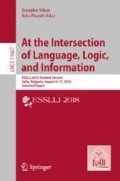Abstract
This paper offers an initial investigation into how the number of choices available to individual agents may influence choice at the group level by formalizing and simulating a social version of the No Alternatives Argument (NAA). The Social NAA assumption predicts that strength of belief in the most strongly held hypothesis in a group of agents will increase when the number of available hypotheses decreases. Social network simulations using connected Bayesian networks show that this assumption can be violated, but infrequently. Implications of the Social NAA assumption and when it holds in social networks are discussed, and future work is outlined.
Access this chapter
Tax calculation will be finalised at checkout
Purchases are for personal use only
Notes
- 1.
Thank you to an anonymous reviewer for bringing this point to attention.
- 2.
Who is permitted to vote in a primary election depends on the state. Open primaries, for instance, allow for any registered voter to vote in any party, regardless of party affiliation. Closed primaries, on the other hand, only allow for registered members of that particular party to vote. The type of primary is not necessary to specify for this example, although it does effect the voters’ calculation of which is the most feasible choice – a voter may, for example, employ a strategy of ‘crossing over’ to vote in the primary for the party he or she is not affiliated with to try to choose the opponent they would prefer to face in the general election.
- 3.
Although the owner of this belief state, whether it is that of the scientific community as a whole or the individual scientists, is not clarified by DHS. This point will addressed in the new model developed in later sections.
- 4.
This iteration of the formal proof borrows from [13].
- 5.
In the original paper, the proposition T is “the hypothesis is empirically adequate”. DHS set up their proof to make inferences about the empirical adequacy of the found hypothesis rather than its truth to avoid the possibility of constructing infinite arguments with superfluous additions, which they claim threatens the validity of the NAA. This is not a point of contention for the new model developed in later sections because the concern is decision-making rather than inference.
- 6.
References
Baltag, A., Christoff, Z., Hansen, J.U., Smets, S.: Logical models of informational cascades. Stud. Log. 47, 405–432 (2013)
van Basshuysen, P.: Dawid et al.’s [2015] no alternatives argument: an empiricist note. Kriter. J. Philos. 29(1), 37–50 (2015)
Beach, L.R.: Broadening the definition of decision making: the role of prechoice screening of options. Psychol. Sci. 4(4), 215–220 (1993)
Berlinski, C.: There Is No Alternative: Why Margaret Thatcher Matters. Hachette, London (2011)
Borgatti, S.P., Everett, M.G.: Models of core/periphery structures. Soc. Netw. 21(4), 375–395 (2000)
Bovens, L., Hartmann, S.: Bayesian Epistemology. Oxford University Press on Demand, Oxford (2003)
Dawid, R., Hartmann, S., Sprenger, J.: The no alternatives argument. Br. J. Philos. Sci. 66(1), 213–234 (2015)
DeGroot, M.H.: Reaching a consensus. J. Am. Stat. Assoc. 69(345), 118–121 (1974)
Douven, I., Riegler, A.: Extending the Hegselmann-Krause model I. Log. J. IGPL 18(2), 323–335 (2009)
Douven, I., Wenmackers, S.: Inference to the best explanation versus Bayes’s rule in a social setting. Br. J. Philos. Sci. 68(2), 535–570 (2015)
Granovetter, M.: The strength of weak ties: a network theory revisited. Sociol. Theor. 1, 201–233 (1983)
Harman, G.H.: The inference to the best explanation. Philos. Rev. 74(1), 88–95 (1965)
Herzberg, F.: A note on “the no alternatives argument” by Richard Dawid, Stephan Hartmann and Jan Sprenger. Eur. J. Philos. Sci. 4(3), 375–384 (2014)
Kuhn, T.S.: Objectivity, value judgment, and theory choice. In: Bird, A., Ladyman, J. (eds.) Arguing About Science, pp. 74–86. Routledge, New York (1977)
Lipton, P.: Inference to the Best Explanation. Routledge, London (2003)
List, C.: Social choice theory. In: Zalta, E.N. (ed.) The Stanford Encyclopedia of Philosophy. Metaphysics Research Lab, Stanford University, Winter 2013 Edition (2013)
Liu, F., Seligman, J., Girard, P.: Logical dynamics of belief change in the community. Synthese 191(11), 2403–2431 (2014)
Longino, H.E.: Science as Social Knowledge: Values and Objectivity in Scientific Inquiry. Princeton University Press, Princeton (1990)
McPherson, M., Smith-Lovin, L., Cook, J.M.: Birds of a feather: homophily in social networks. Annu. Rev. Sociol. 27(1), 415–444 (2001)
Potter, R.E., Beach, L.R.: Decision making when the acceptable options become unavailable. Organ. Behav. Hum. Decis. Process. 57(3), 468–483 (1994)
Russell, S.J., Norvig, P.: Artificial Intelligence: A Modern Approach, 4th edn. Prentice-Hall, Upper Saddle River (2010)
Seligman, J., Liu, F., Girard, P.: Logic in the community. In: Banerjee, M., Seth, A. (eds.) ICLA 2011. LNCS (LNAI), vol. 6521, pp. 178–188. Springer, Heidelberg (2011). https://doi.org/10.1007/978-3-642-18026-2_15
Shah, A.M., Wolford, G.: Buying behavior as a function of parametric variation of number of choices. Psychol. Sci. 18(5), 369 (2007)
Author information
Authors and Affiliations
Corresponding author
Editor information
Editors and Affiliations
Rights and permissions
Copyright information
© 2019 Springer-Verlag GmbH Germany, part of Springer Nature
About this paper
Cite this paper
Edlin, L. (2019). Simulating the No Alternatives Argument in a Social Setting. In: Sikos, J., Pacuit, E. (eds) At the Intersection of Language, Logic, and Information. ESSLLI 2018. Lecture Notes in Computer Science(), vol 11667. Springer, Berlin, Heidelberg. https://doi.org/10.1007/978-3-662-59620-3_1
Download citation
DOI: https://doi.org/10.1007/978-3-662-59620-3_1
Published:
Publisher Name: Springer, Berlin, Heidelberg
Print ISBN: 978-3-662-59619-7
Online ISBN: 978-3-662-59620-3
eBook Packages: Computer ScienceComputer Science (R0)

